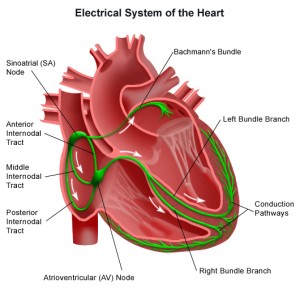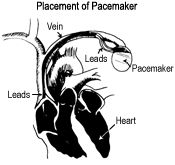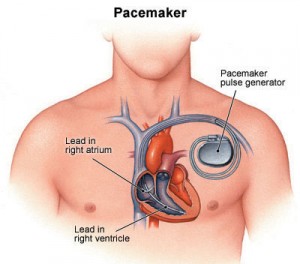What is Arrhythmia?
Broadly defined, arrhythmia refers to any abnormal heartbeat. Irregular heart rhythms are not uncommon, and many people experience an occasional “fluttering” or feel that their heart “skips a beat,” especially as they get older. However, in some severe cases, arrhythmia can be a dangerous condition requiring medical treatment including surgery and/or medical devices to correct the problem.
 The speed and pattern of your heartbeat are both regulated by electrical signals from within your heart. Such signals tell the upper chambers of the heart (atria) to contract to move blood to the lower chambers (ventricles), and tell the ventricles to contract to move blood out to the lungs and to the body. Special electrical cells, called the sinus node, create and send these electrical signals.
The speed and pattern of your heartbeat are both regulated by electrical signals from within your heart. Such signals tell the upper chambers of the heart (atria) to contract to move blood to the lower chambers (ventricles), and tell the ventricles to contract to move blood out to the lungs and to the body. Special electrical cells, called the sinus node, create and send these electrical signals.
If there is a problem with these signals, your heart may beat too quickly (tachycardia), too slowly (bradycardia), or irregularly (arrhythmia). If the electrical signals are not sent or are blocked, a slow heart rhythm (bradycardia) may develop, and blood cannot be pumped and moved throughout the body properly. If too many signals are sent, a fast heart rhythm (tachycardia) may develop. When signals are sent quickly and irregularly, the heart muscle may quiver and fail to beat at all, causing a condition known as fibrillation. Fibrillation can occur in the atria (atrial fibrillation) or in the ventricles (ventricular fibrillation). In extreme cases, fibrillation can cause the formation of blood clots or cardiac arrest.
SURGICAL TREATMENTS
Cardioversion
Certain arrhythmias may be corrected through a process called cardioversion, in which the chest wall is exposed to a well-controlled and perfectly timed electrical shock. Usually an outpatient procedure, the patient is sedated or given general anesthesia. Patients will likely need to continue antiarrhythmic medication following the procedure.
Pacemaker
A pacemaker is designed to treat an abnormally slow heart rhythm. It consists of a small, lightweight electronic device that is surgically placed in your chest for long-term management. The pacemaker continuously monitors your heart rhythm to detect abnormalities. When necessary, it generates an electrical signal, similar to the heart’s natural signals, to regulate your heartbeat at the correct speed.
Pacemakers may have one lead (wire) ending in either the right atrium or right ventricle, or two leads with one ending in the right atrium and one ending in the right ventricle. Some pacemakers are rate-adaptive, meaning they can help adjust your heart rate to your activity level.
Implantable Cardioverter Defibrillator (ICD)
An ICD is a small electronic device that is surgically implanted in your body to continuously monitor your heart rhythm. However, unlike a pacemaker, the ICD is designed to slow down a heart that is beating too fast. It can pace your heart to slow the rhythm down, and, if necessary, send electrical shocks to restore the heart’s normal rhythm. An ICD can also be implanted alongside a pacemaker, and some ICDs contain a pacemaker that can be activated.
Maze Procedure
In severe cases of atrial fibrillation, when other treatments (such as medication, cardioversion and catheter ablation) have failed to correct the problem, your doctor may recommend a maze procedure. This open-heart surgery takes about three hours to complete, and recovery time may last six to eight weeks. This innovative procedure creates a “maze” of new pathways for electrical impulses to travel from the top to the bottom of the heart. It restores a regular coordinated, heartbeat, abolishes atrial fibrillation, and restores coordinated pumping to the upper chambers of the heart.
WHAT TAKES PLACE DURING SURGERY?
Device Implants

Implanting a pacemaker or ICD is a relatively simple and safe procedure, often taking about two hours. The patient may remain awake during the procedure and be given local anesthesia. Typically, an incision is made in the skin below the collarbone to create a small pocket. The lead is threaded into a vein and guided into the heart. The generator is then attached to the lead(s) and placed in the pocket under the skin. Finally, the device is programmed to regulate your heartbeat and the incision is closed.
Maze Procedure
A maze procedure is much more complicated, because the surgeon must actually work on the heart muscle. An incision is made down the center of the chest and the breastbone is split so that the surgeon can access the heart. After being attached to a heart-lung machine, your heart will be stopped and cooled so that the surgeon can make a number of incisions in the upper chambers of the heart. When the procedure is done, the heart is restarted and the patient is removed from the heart-lung machine. The incision is closed.
FOLLOWING SURGERY
Device Implants
Your doctor will monitor your pacemaker or ICD regularly to make sure it is working correctly, and will make adjustments as necessary. Most electronic devices do not interfere with modern pacemakers, so you may return to normal activities within a few weeks. Batteries in the device do wear down and will need to be replaced occasionally
Maze Procedure
Patients recovering from a maze procedure should expect a much longer and more difficult recovery period. Expect to spend about one 5 to 7 days in the hospital, including one or two days in the Intensive Care Unit (ICU). Full recovery may take two to three months.

